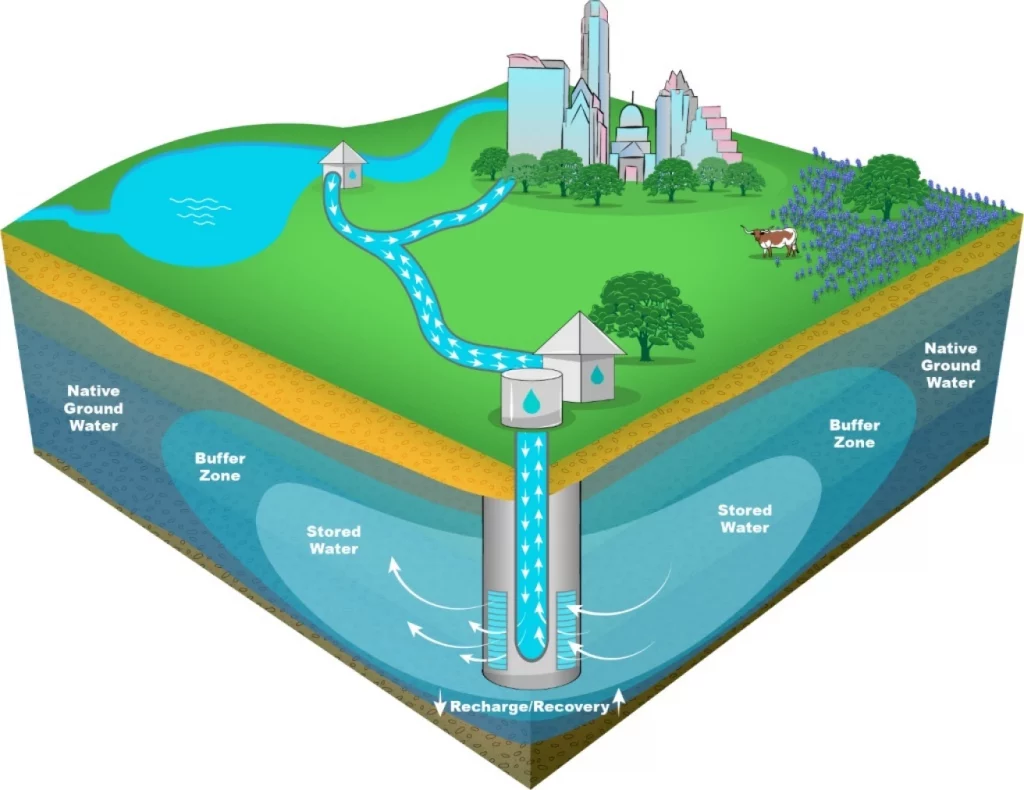Photo by City Of Austin.
Austin is looking for a place to store massive amounts of water to pull from during droughts
Tuesday, October 18, 2022 by
Mose Buchele, KUT Austin is planning a big underground water storage project that would provide the city with another source of water during droughts. But city planners are not sure exactly where to put it. This week, they’ll meet with residents of Lee, Bastrop and Travis counties, the three counties that may end up playing host to the project.
Currently, Austin gets its water from reservoirs in the Highland Lakes along the Colorado River. The new plan is to pump some of that water underground when there’s plenty of it, then pull it back up in times of scarcity.
The system, called aquifer storage and recovery, has been done in other parts of the state, including El Paso and Kerrville, to protect regions from the threat of big droughts.
Under Austin’s plan, the city’s water utility will store about three Lake Austin’s worth of water (60,000 acre feet, in scientific terms) underground by 2040. After that, storage could increase up to 240,000 acre feet (that’s about 11 Lake Austin’s worth of water) by the year 2115.
“The water that will be stored in the cracks, in spaces in the aquifer and the rock and sand,” Marisa Flores Gonzalez, supervisor of Austin Water’s resources team, said. “You can imagine it as a type of giant underground sponge.”
The approach has its benefits. For one thing, it stops water loss from evaporation, something that plagues Texas reservoirs during our hot summers. For another, it reduces the need to build more dams and surface reservoirs, which can be bad for the environment.
“You would have a well field … you would potentially have a pump station, some facilities for treatment, you would have the [water] well heads,” Flores Gonzalez said. “It’s a much smaller footprint than other large water supply projects.”
While the footprint may be smaller than a big reservoir, aquifer storage and recovery still takes complicated engineering and a detailed understanding of local hydrology to implement.
It also requires clear guidelines around water rights and land use to operate effectively.
In Texas, landowners typically have the right to pump water from under their property. One challenge for this type of project is ensuring the city will be able to retrieve the water it injects underground.
“Our intent with this project would be to implement it in a way that would allow us to maintain control over the water we would be storing,” Florez Gonzalez said. “We’re not intending to remove more groundwater than we would be putting into the project.”
Because a big project like this will likely prompt big questions, the city is hosting several workshops this month to provide information and take feedback.
The first of three in-person workshops will happen Tuesday night at the Giddings Public Library and Cultural Center. A second one is planned Wednesday at the Bastrop Public Library. The third will happen Thursday at the Permitting and Development Center.
All workshops start at 6 p.m. You can find more information about those meetings and two virtual events planned later this month here.
Austin Water is not sure where in Lee, Bastrop or Travis County the project may get built. It should have a clearer idea after doing more hydrological studies and completing an “equity and affordability” study which Flores Gonzalez says will look at “the distribution of benefits and burdens” from the project.
The city hopes to have an exact location identified by 2024. After that, it will build and test a pilot program before beginning full-scale design and construction around 2028.
The first phase of the aquifer storage and recovery project, including the pilot program, will cost around $24 million. The full price tag once the project is built out is estimated to be $367 million.
Flores Gonzalez says Austin Water ratepayers will foot the bill. The utility is also considering taking out low-interest state loans “to increase the project’s affordability.”

City of Austin. Illustration of an underground water storage and recovery project.
This story was produced as part of the Austin Monitor’s reporting partnership with KUT.
The Austin Monitor’s work is made possible by donations from the community. Though our reporting covers donors from time to time, we are careful to keep business and editorial efforts separate while maintaining transparency. A complete list of donors is available here, and our code of ethics is explained here.
You're a community leader
And we’re honored you look to us for serious, in-depth news. You know a strong community needs local and dedicated watchdog reporting. We’re here for you and that won’t change. Now will you take the powerful next step and support our nonprofit news organization?











